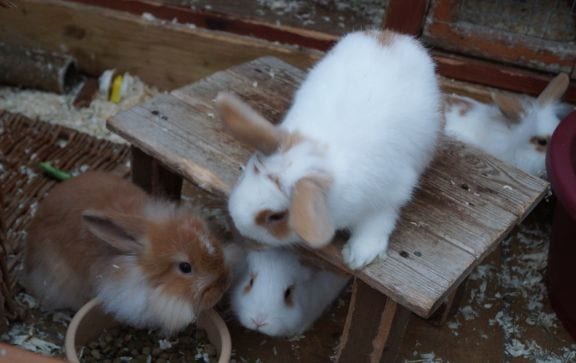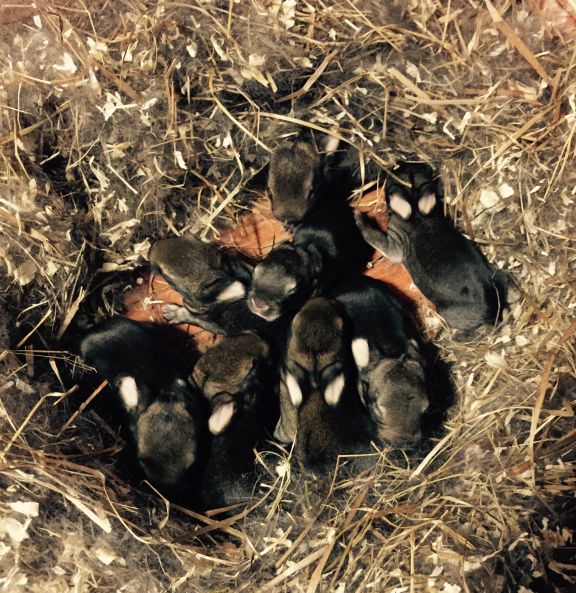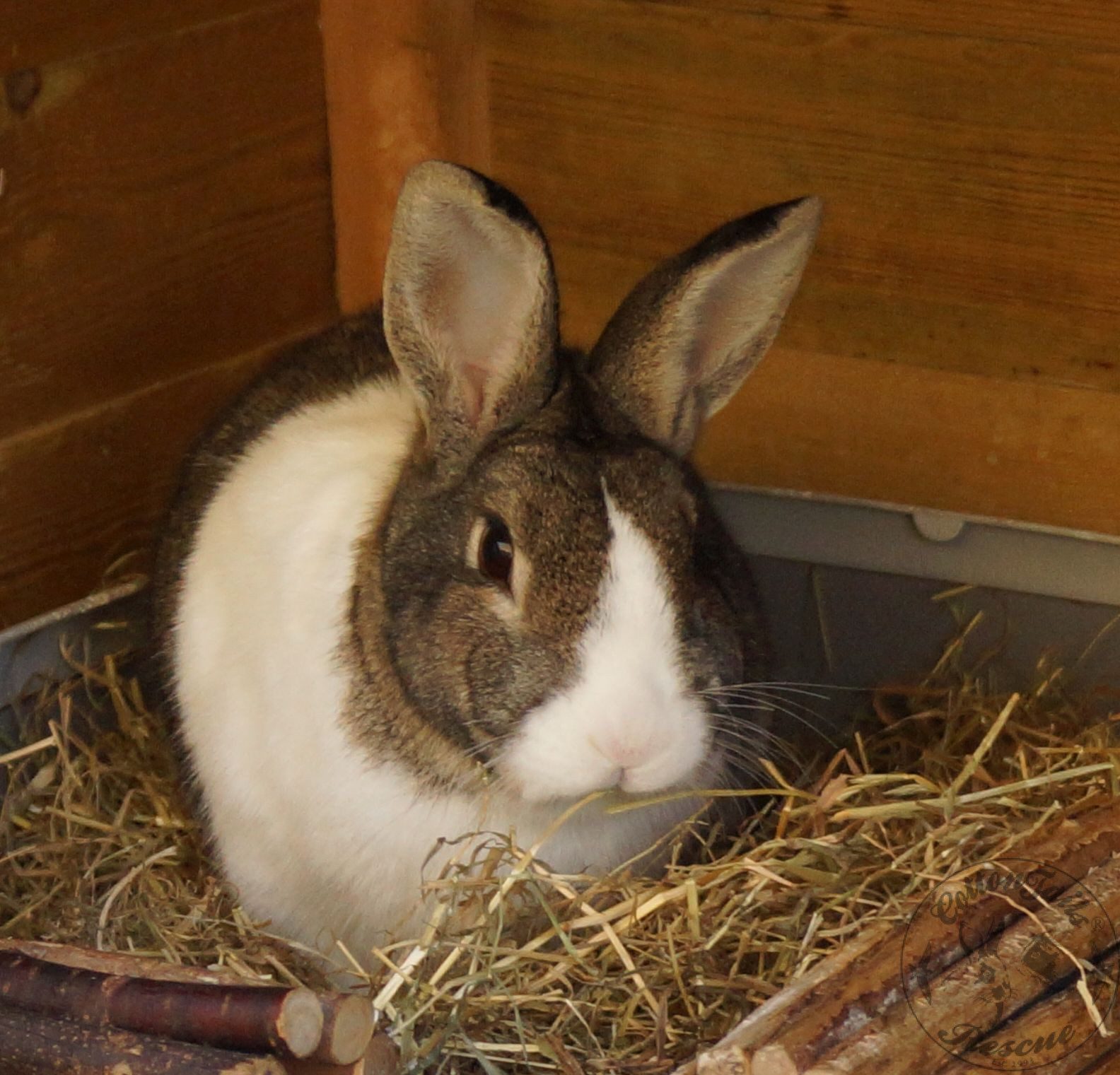Rabbits come in many shapes, sizes, colours and breeds, and this variation is true for personality, too. While many traits can be attributed to breed characteristics, the newborn’s environment can influence the rabbit’s personality. This can determine how confident and relaxed a rabbit is in its human interactions. Research has shown that around 60% of pet rabbits exhibit fear responses and physically struggle when being picked up and held (Bradbury & Dickens, 2016). Therefore, anything that could potentially reduce the stressors of handling a rabbit should be considered. Whilst keeping the physical lifting of a rabbit to a minimum by training the rabbit to hop into a pet carrier for events such as vet appointments for example, it would still be an advantage if the rabbit could deal with such stress factors from a young age.
It takes a relatively short time for a group of unneutered pet rabbits to revert to exhibiting the traits of their wild ancestors. I have witnessed this on several occasions when I have been called in to rescue a group that has turned feral. In each case, the colony started with two or three tame pet rabbits allowed complete freedom in a garden. Within a short time, the original handful of pets became scores of young rabbits of various ages that behaved like wild rabbits, running away into their burrows as soon as anyone approached. They had become untouchable and independent, and catching such individuals proved tricky.

In time and with a lot of patience and gentle contact – very much at their pace and on their terms – most of these rabbits gradually overcame their fears. Still, none of them ever really became properly tame, which indicated to me the importance of reducing the fear of humans in rabbits when they are very young if they are to make good pets and live happy, confident lives. Helping rabbits overcome their fears is called socialisation and habituation, the process where an animal becomes accustomed to non-threatening environmental stimuli and learns to ignore them (Dyles 2006). I like to refer to this process as desensitisation.
However, the task of reducing fear in young rabbits immediately introduces a conflict of interest: Baby rabbits are at risk of being abandoned or harmed by their mother if she feels her nest area is being disturbed, and yet, somehow, we need to start the process of desensitisation as soon as possible. What is the answer?
As with most things in life, a compromise is required, and this also is dependent on how well the owner knows the mother rabbit and how good a relationship there is between them. The rabbit’s personality type is also important, as a very nervous and anxious bunny will have to have a different approach than one already calm and relaxed around daily human activities.
The best way forward for either type of personality is to start by checking the nest daily, but make sure that mum is either out in her run or distracted at the other end of her pen while eating her food. First, run your hands along some of her soiled bedding and then, whilst mum is out of the way, gently part the fur in the nest and count the babies, making sure they are all together in one pile and that they all look round and content. This should be done daily from birth, not only to make sure all is well but also to start to introduce human scent to start the desensitisation process. For a very nervous mum, you need to ensure she is not allowed back in with the babies for an hour or so afterwards to give the babies time to settle back down again so she does not become agitated.

By 10-12 days, the babies’ eyes will start to open, so by continuing to check the nest daily, you will begin to build up your regular contact with them, and they should not be afraid. The best time to check them is in the morning so they are still full from their night-time feed and don’t all pop up excitedly thinking you are mum with their next meal. Once their eyes are open, you can gently pick up each baby for a few seconds to give it a stroke before returning it. So long as the mum bunny is relaxed with this and still making sure she is distracted elsewhere during the process as a precaution, you can gradually increase the length of time each baby is held. Make sure that you are feeling calm and confident and that there are no loud noises – choosing to handle them whilst a neighbour is using a noisy lawn mower would not be ideal.
There is evidence that this careful handling of kits in the nest is at its most effective if it is carried out shortly before or after they are fed (Dúcs et al. 2009). This presents various practical issues, not least that it can be impossible to determine precisely when the doe will feed her young, especially if it happens to be in the early hours of the morning. Placing an object with a familiar human scent, such as a cloth (Bradbury & Dickens 2016), near the nest before birth may be helpful, especially when a doe is agitated and nervous. The principle behind this is exposing mum and the kits to human scent without physically disturbing the nest. However, personal experience has shown that the chances of such an object staying put would be slim as it would either end up in the nest where it would get quickly soiled or moved away from the area entirely by the doe and dumped in the litter tray corner.
Although there is little scientific research into what actual age socialisation needs to start from, the evidence indicates that it is vital that this socialisation process is begun before the babies are 21 days old (Dyles 2006). If the mum bunny is deemed at high risk of abandoning her litter, it may be best to wait until the babies have their eyes open before starting any actual contact, as her feeding routine with them should be well established by then.
Positive contact with the babies should be continued until they are old enough to leave mum and find new homes, by which time you will have done your best to give them the best start possible. However, even with the best intentions, there is often still a variation in desensitisation success within a litter, and there are usually one or two individuals who remain more cautious than the others, possibly a trait they may never lose. This is likely down to inherited behavioural characteristics. However, at least by early positive handling, you will still have given such individuals an advantage over other youngsters who were not desensitised at all.
References
- Bradbury & Dickens (2016) Appropriate handling of pet rabbits: a literature review. Journal of Small Animal Practice.
- Dyles (2006) Breeding pet rabbits, health and welfare considerations.
- Dúcs et al (2009). Physical contact while handling is not necessary to reduce fearfulness in the rabbit. Applied Animal Behaviour Science 121, 51-54

